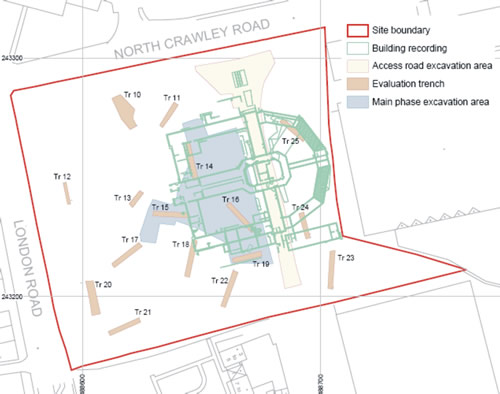Building on the past
It used to be thought that the story of Renny Lodge Hospital in Newport Pagnell began in 1836. Thanks to archaeologists we now know that the first chapter of this story started almost 2,000 years earlier. Today, builders are writing another chapter in the story of Renny Lodge.
The history
The first building that history records on the site was a workhouse, built in 1836. In 1834 the Poor Law Amendment Act had been passed with the intention of deterring the able bodied from claiming poor relief and to provide a refuge for the sick and homeless.
As a result Newport Pagnell was one of many towns to be formed into a Poor Law Union. A Board of Guardians was elected and they decided on a workhouse design by William Roote, who had designed workhouses in nearby towns. The first inmates entered the Newport Pagnell Union Workhouse on the 8 th of April 1837.
In 1929 the Local Government Act abolished workhouses and the building was transferred to the Local Authority. This is when the Workhouse first became known as Renny Lodge Hospital . It was used primarily for caring for the elderly and the chronically ill. In 1948 the responsibility for running the hospital was transferred to the new National Health Service and Renny Lodge was an NHS hospital until its closure in 1992.
The archaeology
The hospital was demolished in 1994 and the site lay unused until 2005 when archaeologists were called in.
The foundations of the hospital were to be removed to allow new houses to be built. This would give archaeologists their first chance to see beneath the building and see what had happened at Renny Lodge before 1836.

The survey identified and mapped how the building had been changed and modified during its 170 year history. Once this was done, the foundations of the old Workhouse and Hospital were removed, opening a new and older chapter in the story of the site.
As the archaeologists began to dig below the foundations they pushed back the site's history into the medieval period. They uncovered field boundaries, the marks left by the roots of rows of trees, a trackway and patches of cobbling that may have been from yards or tracks.

As excavation continued it became apparent that the site had been used much earlier: in Roman times. The first traces were fields dating from the 1 st – mid 2 nd century AD. A curving ditch might mark the site of a round house. Patches of cobbling were found over patches of soft clay. These may have been to firm up soft ground or, more likely, the cobbling covered a larger area, but it only survives today where it was squashed down into the softer clay.
During the 2 nd century AD the fields continued to be farmed. A track that may have started in the 1 st century become a proper road, with drainage ditches either side. The assortment of pottery and other finds suggests that there was a small roadside settlement, which had its own waterhole.
The settlement was occupied for another 100 years but probably went out of use by 300 AD at the latest, perhaps a hundred years before the end of the Romano-British period.
The future
The excavations have allowed archaeologists to write a new chapter in the story of Renny Lodge. This story is almost 2000 years old, starting with a small Romano-British roadside settlement, then medieval fields and tracks, and then the establishment of a 19 th century workhouse which was incorporated into the emergent National Health Service.
It is perhaps fitting that archaeological investigations have revealed the story that precedes the 3rd millennium occupation at Renny Lodge, with the affordable housing now being built at Renny Lodge being the latest chapter.
